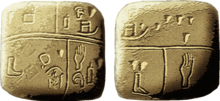The Kish tablet is a limestone tablet found at the site of the ancient Sumerian city of Kish in modern Tell al-Uhaymir, Babylon Governorate, Iraq. A plaster cast of the tablet is in the collection of the Ashmolean Museum, while the original is housed at the Iraq Museum in Baghdad.[1][2] It should not be confused with the Scheil dynastic tablet, which contains part of the Sumerian King List and is also sometimes called the Kish tablet.[3]
 Limestone tablet from Kish (Sumer) with pictographic writing, Late Uruk period – Ashmolean Museum | |
| Geographical range | Iraq |
|---|---|
| Period | Late Uruk period (c. 3500–2900 BC) |
| Dates | After 3500 BC |
| Followed by | Narmer Palette |
The signs on the Kish tablet, possibly related to proto-cuneiform, are purely pictographic, and have not been deciphered or demonstrated to correspond to human language. It has been dated to the Late Uruk period (c. 3500–2900 BC).[4][5]
See also
editReferences
edit- ^ [1]Henry Field, "The Field Museum-Oxford University Expedition to Kish, Mesopotamia, 1923–1929", Anthropology Leaflet, no. 28, 1929.
- ^ Langdon, Stephen, "Excavations at Kish: The Herbert Weld (for the University of Oxford) and Field Museum of Natural History (Chicago) Expedition to Mesopotamia. Vol. 1", P. Geuthner, 1924.
- ^ Scheil, Vincent (1911). "Les plus anciennes dynasties connues de Sumer-Accad". Comptes rendus des séances de l'Académie des Inscriptions et Belles-Lettres (in French). 55 (8): 606–620.
- ^ Hayes, John L., 1990 A Manual of Sumerian Grammar and Texts, Undena Publications
- ^ Woods, Christopher (2010), "The earliest Mesopotamian writing" (PDF), in Woods, Christopher (ed.), Visible language. Inventions of writing in the ancient Middle East and beyond, Oriental Institute Museum Publications, vol. 32, Chicago: University of Chicago, pp. 33–50, ISBN 978-1-885923-76-9
Further reading
edit- A. C. Moorhouse, The Triumph of the Alphabet: A History of Writing